Unit 6 礼仪性口译
Unit_6_礼仪性口译(汉译英)

开幕祝词 An Opening Speech
1. 宣布…开幕 declare… open /declare the
opening of
2. 论坛
forum
3. 市民社会 civil society
4. 文化多样性 cultural pluralism
5. 筹委会
organizing committee
圣诞节是一年中的良辰佳时,圣诞节聚会 象征着人间的温暖,团聚和奉献。//
Christmas is a wonderful time of the year (a very wonderful and joyous occasion of the year ) and the Christmas Party symbolizes warmth, union and dedication of mankind. //
我希望我们能保持这种务实的合作关系, 使明年的业绩更加辉煌,让我们共同举杯, 为明年再创佳绩干杯!
I hope we can maintain this practical cooperative relations to make the coming new year a more fruitful year. Please join me in a toast to greater achievements next year! Cheers!
全体同仁
all the colleagues
从百忙当中拨冗光临 take the time off the busy
schedule
新春联欢晚会
Chinese New Year’s
Party /Spring Festival gathering /Spring Festival
礼仪口译
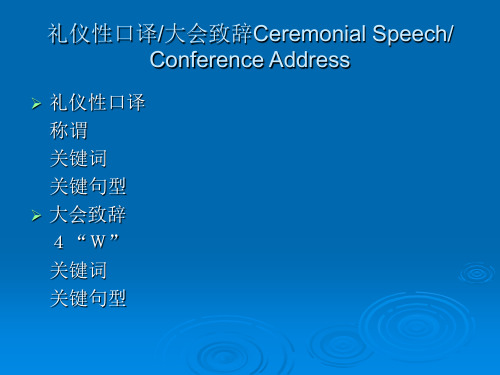
But the UK delegation also includes many distinguished academic researchers at the forefront of their fields—and, as a fields— reminder of the excellence of UK science, it is good to see Harry Kroto, one of the UK’s Nobel Laureates, here today.
关键词 Banquet host the banquet in honor of…. __________welcome __________invitation __________hospitality __________thanks/ __________thanks/gratitude __________visits __________ wishes /greetings Propose a toast to……
This has been a week of extraordinary activity and variety in Shanghai as UK organizations have laid on a whole range of activities and exhibitions to demonstrate the creativity and innovation in the 21st century.
As the Ministry of Science and Innovation, I am therefore delighted that science and technology brings this week to a satisfactory close and I am particularly pleased that so many key players in some of the UK’s leading firms are able to be here to式/词 预祝..圆满成功 请允许我宣布..开幕/ 请允许我宣布..开幕/闭幕 祝各位身体健康,万事如意
礼仪致辞文章口译

礼仪致辞文章口译尊敬的……distinguished; honorable; honored; respected …受/承蒙……的(盛情)邀请at the (gracious) invitation of …借此机会to take this opportunity to;to avail myself this opportunity to 代表on behalf of …表示to extend; to express; to convey值此……之际on the occasio n of…以……的名义in the name of …; in one’s name进行国事/友好访问to pay a state/goodwill visit to …由衷的谢意heartfelt thanks; sincere thanks在……的气氛中in a/an … atmosphere陛下 your/his/her majesty殿下 your/his/herhighness/excellency/royal highness 阁下 your/his/her honor /excellency 夫人 madam东道国 host country值此??之际 on the occasion of以??的名义 in the name of由衷的谢意 heartfelt thanks承蒙位??的盛情邀请 at the gracious invitation of二,荣幸地答谢您给予我们的热情招待 have the honor of reciprocating your warm reception怀着对贵国人民的深厚感情 with profound and amicable sentiments for your people作为贵国人民的友好使者 as an envoy of friendship of your people增进我们彼此之间的理解和友谊increase/strengthen/promote/expandour mutual understanding and friendship促进我们之间的友好合作关系promote/facilitate/enhance/strength en /advance our friendly relations of cooperation回顾过去 look back on;in retrospect 展望未来 look ahead;look into the future最后 in conclusion /closing提议祝酒 propose a toast现在,我愉快地宣布第二十二届万国邮政联盟大会开幕。
礼仪致辞口译范文段落摘抄

礼仪致辞口译范文段落摘抄英文回答:Welcome Address for a Conference.Honorable guests, distinguished speakers, ladies, and gentlemen, a very good day to all of you.On behalf of the organizing committee, I extend a warm welcome to you all as we gather today to delve into the intriguing realm of the conference theme, "Artificial Intelligence: Unlocking Human Potential."As technology continues to advance at an unprecedented pace, artificial intelligence (AI) has emerged as a pivotal force, promising to transform various aspects of our lives and industries. This conference provides an invaluable platform for us to explore the multifaceted facets of AI, its profound implications, and the immense opportunities it presents.Throughout the duration of the conference, we will engage in stimulating discussions, delve into thought-provoking presentations, and partake in interactive workshops led by renowned experts and thought leaders in the field of AI. We are honored to have assembled a distinguished lineup of speakers who will delve into various dimensions of AI and its potential impact on domains ranging from healthcare to finance and beyond.Our aim is to foster an environment of intellectual exchange, collaboration, and innovation. We encourage you to actively participate in the discussions, pose questions, and share your perspectives. By engaging in robust dialogues, we can collectively harness the transformative power of AI for the betterment of society.I extend my sincere gratitude to our esteemed speakers, sponsors, and organizing committee members for their unwavering support and dedication in making this conference a resounding success. I am confident that the knowledge and insights gained over the next few days will serve as acatalyst for groundbreaking ideas and inspire us to embrace the transformative potential of AI.Once again, a warm welcome to all. May this conference be a memorable and enriching experience for each and every one of you.Address at a University Graduation Ceremony.Graduates, faculty members, parents, and distinguished guests, it is with immense pride and joy that I stand before you today to celebrate this momentous occasion, the culmination of your academic journeys.On behalf of the university, I extend heartfelt congratulations to the Class of 2023. Your dedication, perseverance, and unwavering pursuit of knowledge have brought you to this milestone. You have equipped yourselves with the skills, knowledge, and critical thinking abilities that will empower you to navigate the challenges and embrace the opportunities that lie ahead.As you embark upon the next chapter of your lives, I urge you to carry with you the values instilled within these hallowed halls. Let integrity, compassion, and a thirst for lifelong learning guide your actions. Remember that your alma mater will always be your home, and we will continue to cheer you on every step of the way.Today, you stand on the precipice of boundless possibilities. The world beckons you to make your mark and shape the future. Embrace the unknown with curiosity, take calculated risks, and never cease to challenge yourselves. By harnessing your knowledge and passion, you can make meaningful contributions to your communities and the world at large.As you step into the wider world, remember the lessons you have learned here. Be empathetic listeners, effective communicators, and responsible global citizens. Utilize your knowledge to foster a more just, equitable, and sustainable society.To the parents, guardians, and loved ones who havesupported these graduates throughout their academic endeavors, I extend my sincere appreciation. Your unwavering belief in them has been instrumental in their success.In closing, I leave you with the words of the renowned scientist and philosopher Albert Einstein: "The important thing is not to stop questioning. Curiosity has its own reason for existing."Congratulations, graduates! Continue to question, explore, and dream boldly. Your journey has only just begun.中文回答:欢迎辞。
Unit6礼仪性口译
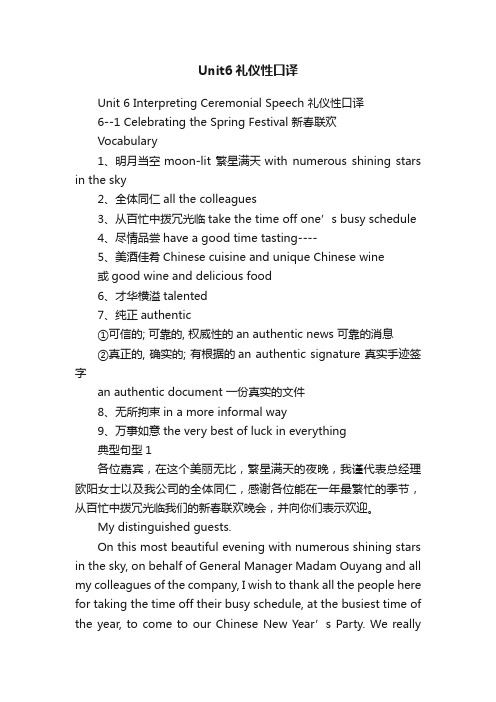
Unit6礼仪性口译Unit 6 Interpreting Ceremonial Speech 礼仪性口译6--1 Celebrating the Spring Festival 新春联欢Vocabulary1、明月当空moon-lit 繁星满天with numerous shining stars in the sky2、全体同仁all the colleagues3、从百忙中拨冗光临take the time off one’s busy schedule4、尽情品尝have a good time tasting----5、美酒佳肴Chinese cuisine and unique Chinese wine或good wine and delicious food6、才华横溢talented7、纯正authentic①可信的; 可靠的, 权威性的an authentic news 可靠的消息②真正的, 确实的; 有根据的an authentic signature 真实手迹签字an authentic document 一份真实的文件8、无所拘束in a more informal way9、万事如意the very best of luck in everything典型句型1各位嘉宾,在这个美丽无比,繁星满天的夜晚,我谨代表总经理欧阳女士以及我公司的全体同仁,感谢各位能在一年最繁忙的季节,从百忙中拨冗光临我们的新春联欢晚会,并向你们表示欢迎。
My distinguished guests.On this most beautiful evening with numerous shining stars in the sky, on behalf of General Manager Madam Ouyang and all my colleagues of the company, I wish to thank all the people here for taking the time off their busy schedule, at the busiest time of the year, to come to our Chinese New Year’s Party. We reallyappreciate your presence here tonight with us.练习各位嘉宾,在这个特别的日子里,我代表这对新人感谢大家从百忙之中拨冗光临他们的结婚典礼。
礼仪祝词口译词汇表
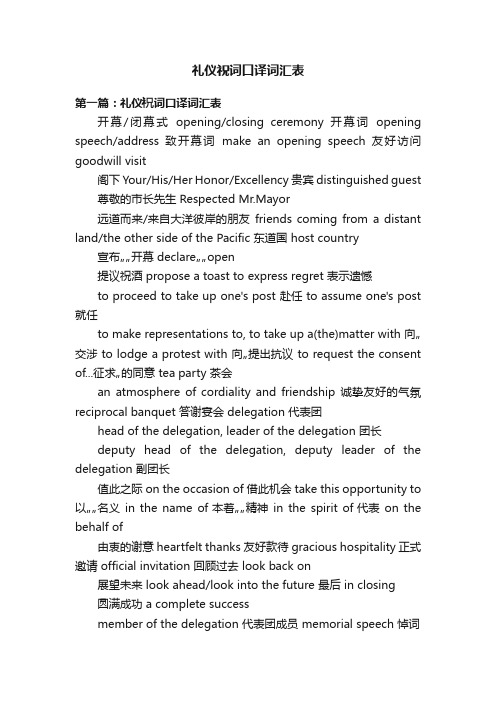
礼仪祝词口译词汇表第一篇:礼仪祝词口译词汇表开幕/闭幕式opening/closing ceremony 开幕词opening speech/address 致开幕词make an opening speech 友好访问goodwill visit阁下 Your/His/Her Honor/Excellency 贵宾 distinguished guest 尊敬的市长先生 Respected Mr.Mayor远道而来/来自大洋彼岸的朋友friends coming from a distant land/the other side of the Pacific 东道国 host country 宣布……开幕declare……open提议祝酒 propose a toast to express regret 表示遗憾to proceed to take up one's post 赴任 to assume one's post 就任to make representations to, to take up a(the)matter with 向…交涉 to lodge a protest with 向…提出抗议 to request the consent of...征求…的同意 tea party 茶会an atmosphere of cordiality and friendship 诚挚友好的气氛reciprocal banquet 答谢宴会 delegation 代表团head of the delegation, leader of the delegation 团长deputy head of the delegation, deputy leader of the delegation 副团长值此之际 on the occasion of借此机会 take this opportunity to 以……名义in the name of本着……精神in the spirit of代表on the behalf of由衷的谢意 heartfelt thanks 友好款待 gracious hospitality 正式邀请 official invitation 回顾过去 look back on展望未来 look ahead/look into the future 最后 in closing圆满成功 a complete successmember of the delegation 代表团成员 memorial speech 悼词to develop the relations of friendship and cooperation 发展友好合作关系prosperity and strength 繁荣富强friendly visit, goodwill visit 友好访问questions of common interest;question of common concern 共同关心的问题 state banquet 国宴message of greeting, message of congratulation 贺电 speech of welcome 欢迎词 welcoming banquet 欢迎宴会 cocktail party 鸡尾酒会good health and a long life 健康长寿profound condolence 深切哀悼 to receive 接见cordial hospitality 盛情接待 to be shocked to learn of 惊悉the two sides, the two parties 双方 be of the opinion, to hold, to consider, to maintain 认为luncheon 午宴 to propose a toast to...提议为…干杯reception 招待会 on the happy occasion of 欣逢toast 祝酒词 on learning with great joy 欣悉to convey one's sympathy 表示慰问to give a banquet in honour of...宴请…to meet with 会见 on invitation, upon invitation 应邀to review the guard of honour 检阅仪仗队 at the invitation of...应…邀请to exchange views 交换意见in the company of..., accompanied by...在…陪同下to express one's sincere congratulations and best wishes 致以衷心的祝贺和最好的愿望to wish prosperity to a country and well-being to its people 祝(某国)国家繁荣人民幸福to take note of...注意到 dance(party), ball, fandango 舞会His(Her, Your)Majesty 陛下 reading party 读书会His(Her, Your)Royal Highness 殿下 fishing party 钓鱼会His(Her, Your)Excellency 阁下 sketching party 观剧会His Excellency Mr.President and Mme...…总统先生阁下和夫人Christmas party 圣诞晚会luncheon party 午餐会assembly 大会 fancy ball 化妆舞会convention 会议 commemorative party 纪念宴会party 晚会, 社交性宴会 wedding dinner, a wedding reception 结婚宴会at-home party 家庭宴会 banquet 酒宴tea party 茶会 buffet party 立食宴会dinner party 晚餐会 cocktail party 鸡尾酒会garden party 游园会 welcome meeting 欢迎会farewell party 惜别会 congress 代表大会pink tea 公式茶会 board of directors 董事会New Year’s banquet 新年会executive council, executive board 执行委员会year-end dinner party 忘年餐会 standing body 常设机构box supper 慈善餐会 committee, commission 委员会fancy fair 义卖场 subcommittee 附属委员会,小组委员会general meeting, general assembly 会员大会general committee, general officers, general bureau 总务委员会 session 会期,会议期间(美作:meeting)secretariat 秘书处 working party 工作小组budget committee 预算委员会 seat, headquarters 席位drafting committee 起草委员会 governing body 主管团体committee of experts 专家委员会 round table 圆桌advisory committee, consultative committee 顾问委员会,咨询委员会symposium 讨论会 to sit a meeting, to meet a meeting, to hold a meeting 召开会study group 学习研讨会 opening speech 开幕式致辞seminar 讲习会,学习讨论会small-and medium-sized enterprises 中小型企业meeting in camera 秘密会议(美作:executive session)farmer-turned-entrepreneur 农民企业家opening sitting 开幕会 clean energy 清洁能源final sitting 闭幕会 basic medical insurance 基本医疗保险formal sitting 隆重开会 crops' minimum purchase prices 粮食最低收购价plenary meeting 全会 per-capita income 人均收入sitting, meeting 开会(美作:session)window guidance 窗口指导(监管机构利用其在金融体系中特殊的地位和影响,引导金融机构主动采取措施防范风险,进而实现监管目标的监管行为。
礼仪类口译(共五则范文)
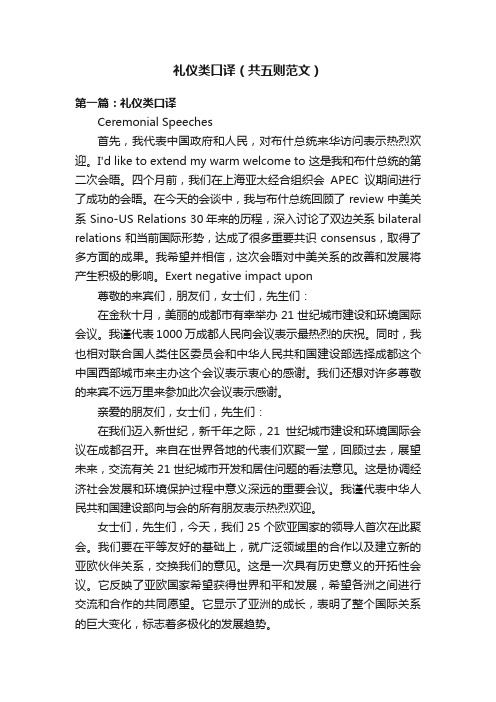
礼仪类口译(共五则范文)第一篇:礼仪类口译Ceremonial Speeches首先,我代表中国政府和人民,对布什总统来华访问表示热烈欢迎。
I'd like to extend my warm welcome to 这是我和布什总统的第二次会晤。
四个月前,我们在上海亚太经合组织会APEC议期间进行了成功的会晤。
在今天的会谈中,我与布什总统回顾了review中美关系 Sino-US Relations 30年来的历程,深入讨论了双边关系bilateral relations和当前国际形势,达成了很多重要共识consensus,取得了多方面的成果。
我希望并相信,这次会晤对中美关系的改善和发展将产生积极的影响。
Exert negative impact upon尊敬的来宾们,朋友们,女士们,先生们:在金秋十月,美丽的成都市有幸举办21世纪城市建设和环境国际会议。
我谨代表1000万成都人民向会议表示最热烈的庆祝。
同时,我也相对联合国人类住区委员会和中华人民共和国建设部选择成都这个中国西部城市来主办这个会议表示衷心的感谢。
我们还想对许多尊敬的来宾不远万里来参加此次会议表示感谢。
亲爱的朋友们,女士们,先生们:在我们迈入新世纪,新千年之际,21世纪城市建设和环境国际会议在成都召开。
来自在世界各地的代表们欢聚一堂,回顾过去,展望未来,交流有关21世纪城市开发和居住问题的看法意见。
这是协调经济社会发展和环境保护过程中意义深远的重要会议。
我谨代表中华人民共和国建设部向与会的所有朋友表示热烈欢迎。
女士们,先生们,今天,我们25个欧亚国家的领导人首次在此聚会。
我们要在平等友好的基础上,就广泛领域里的合作以及建立新的亚欧伙伴关系,交换我们的意见。
这是一次具有历史意义的开拓性会议。
它反映了亚欧国家希望获得世界和平和发展,希望各洲之间进行交流和合作的共同愿望。
它显示了亚洲的成长,表明了整个国际关系的巨大变化,标志着多极化的发展趋势。
Unit6 日常交流礼仪

地位身份低者先递送,男士先送。如己方多人,地位高 者先递送。对方多人,先递送给地位高者; 正视对方,面带微笑,双手拇指和食指分别捏着名片两 角,名片正面面向对方,送至胸前,同时报上姓名 ”请多关照“等加深印象。 2.接受有方 一般应起身或欠身,面带微笑,双手拇指食指捏住下方 两角,并致谢。接过名片后,应从头至尾把基本内容默 读一遍,最好口头称呼对方头衔“久仰”,不可随手放 入口袋;当面放入名片夹或上衣口袋,不可把玩乱放。 一般需“有来有往”,回赠名片。
Unit6 日常交流礼仪 (Communications & Topics)
称呼(addressing others)
1. 家庭成员,亲朋好友,熟人同事间可直呼其名,昵称 George Bush= George,Georgie Henry=harry, James=Jimmy, Adam=Addie, Edward=Teddy, Eddie, Richard=Dick, Anne=Nancy, Caroline=Cala, Lina, Emily=Emily Elizabeth=Liza, Katherine=Kate, Kit, Susan=Sue 2. 其他人称呼 Mr. Mrs. Miss Ms. Sir Madam (Ma’am)
Байду номын сангаас
重要场合:主方或双方在场身份最高者 社交场合:双方都熟悉的人士,先征得地位高者意愿 2)介绍顺序 “先主后宾”,“尊者居后”,(优先知情权)“长 辈居后” “女士居后” May I introduce…to you? Would you mind me introducing… … I’d like you to meet … 3.介绍集体 1)单向式: 如一方是个人,另一方是集体,只需把 个人介绍给集体。 2)双向式:双方都是集体,先主方负责人以身份地位 自高而低依次介绍,再由客方负责人介绍客方人员
口译系列(礼仪接待)

口译系列(礼仪接待)第一篇:口译系列(礼仪接待)口译系列:礼仪祝词礼仪自古以来就被视为人际相交的润滑剂,恰如其分的礼仪可以增进了解、加深友谊。
在外事活动中,讲究礼仪也是必不可少的。
第一部分基本词汇开幕/闭幕式opening/closing ceremony 开幕词opening speech/address 致开幕词make an opening speech 友好访问goodwill visit阁下 Your/His/Her Honor/Excellency 贵宾 distinguished guest 尊敬的市长先生 Respected Mr.Mayor 远道而来/来自大洋彼岸的朋友friends coming from a distant land/the other side of the Pacific 东道国 host country 宣布……开幕declare……open 值此之际 on the occasion of 借此机会take this opportunity to 以……名义in the name of 本着……精神 in the spirit of 代表 on the behalf of 由衷的谢意heartfelt thanks 友好款待gracious hospitality 正式邀请officioa invitation 回顾过去look back on 展望未来look ahead/look into the future 最后 in closing 圆满成功 a complete success 提议祝酒 propose a toast 第二部分词语扩展一、政治词汇亚太地区Asian-Pacific region 建交establishment of diplomatic relations between 互访exchange of visit 外交政策foreign policy 一贯奉行 in persistent pursuit of 平等互利 equality and mutual benefit 双边关系bilateral relations 持久和平lasting peace二、政治词汇贸易额trade volume 商业界business community 跨国公司 transnational corporation 经济强国/经济大国/经济列强(视具体情况翻译)economic power 第三部分例句1.我愿借此机会,代表我们代表团的全体成员,对我们东道主的诚挚邀请,表示真诚的谢意。
Unit礼仪性口译

U n i t5I n t e r p r e t i n g C e r e m o n i a l S p e e c h礼仪性口译5--1 Revisiting the Old Haunt 故地重游haunt①以鬼神的形式出现to inhabit, visit, or appear to in a form of a ghost or other super natural being②经常拜访,常去/常去的地方to visit often/frequently I haunted the movie theaters.③时常萦绕心头to come to mind continually a riddle that haunted me all the morning 一个困扰我一个上午的谜语。
Vocabulary1、world-renowned 举世着名的renowned well-known or famous2、diversity 原义:不同、差异、多样性本文:气象万千3、dynamism 充满活力full of vigorousness adj: dynamic4、nostalgic 思念的,怀旧的n. nostalgia①怀旧long for things, persons, or situations of the past②想家的状况/想家the conditions of being homesick/homesickness5、utmost courtesy 高度的礼貌utmost: 极限的,极高的the maximum/ highest or greatest of degree6、overshadow 弱化①To cast a shadow over; darken or obscure.向…投上阴影;使暗淡:在…上面投上一个阴影;使变暗或使模糊②To make insignificant by comparison;使显得不重要,使相形见拙:通过对比使不重要7、non-governmental sector 民间机构8、good faith 良好的诚意典型句型1Permit me first to thank you, our Chinese hosts, for your extraordinary arrangements and hospitality.首先,请允许我感谢中国主人的精心安排与好客。
口译:礼仪单句+答案
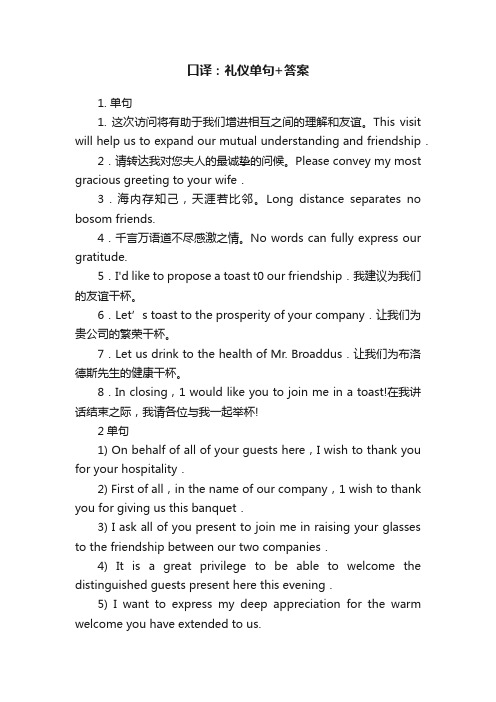
口译:礼仪单句+答案1. 单句1. 这次访问将有助于我们增进相互之间的理解和友谊。
This visit will help us to expand our mutual understanding and friendship.2.请转达我对您夫人的最诚挚的问候。
Please convey my most gracious greeting to your wife.3.海内存知己,天涯若比邻。
Long distance separates no bosom friends.4.千言万语道不尽感激之情。
No words can fully express our gratitude.5.I'd like to propose a toast t0 our friendship.我建议为我们的友谊干杯。
6.Let’s toast to the prosperity of your company.让我们为贵公司的繁荣干杯。
7.Let us drink to the health of Mr. Broaddus.让我们为布洛德斯先生的健康干杯。
8.In closing,1 would like you to join me in a toast!在我讲话结束之际,我请各位与我一起举杯!2单句1) On behalf of all of your guests here,I wish to thank you for your hospitality.2) First of all,in the name of our company,1 wish to thank you for giving us this banquet.3) I ask all of you present to join me in raising your glasses to the friendship between our two companies.4) It is a great privilege to be able to welcome the distinguished guests present here this evening.5) I want to express my deep appreciation for the warm welcome you have extended to us.1) 我谨代表所有在座的客人,对你们的盛情款待表示感谢。
Unit 6 礼仪性口译(汉译英)
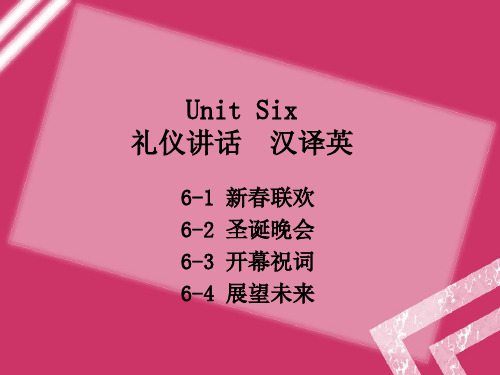
• 我们尽自己之所能,幵将继续竭尽全力使各位度过一个最 轻松、最欢乐、最难忘的夜晚。 We did and will continue to do our best to make tonight most relaxing, most enjoyable and most memorable for you. 1. do one’s best/try one’s best. 2. memorable /unforgettable 3. make ……more beautiful 4. make …… more fruitful. 5 . provide a most ……night for you, ….
段落练习
• 在这明月当空的中秋之夜,我很高兴能应邀出席 贵公司的庆祝晚宴,同各位一起度过一个轻松、 难忘的夜晚。// • 在这个高度竞争的时代,人际关系越来越紧张, 似乎缺少了传统意义上的那种人间温暖的关怀。 // • 我国的中秋节不仅给人们提供了团聚的机会,其 意义还包含了关怀、融洽和奉献。我为有幸参加 这次中秋聚会,再次表示感谢。
• 各位还将欣赏到我校一些多才多艺的青年教工所表演的中国味纯正的 文艺节目。 Later on, you will enjoy the authentic Chinese entertainment performed by some versatile young teachers from our university. 欣赏 enjoy/admire, 多才多艺的versatile/ talented, 名词versatility 中国味: Chinese 纯正 authentic/pure 长句分译 各位将要欣赏节目 / 节目由我公司才华横溢的青年员工表演 / 具有 纯正中国味道的节目 — You will enjoy some performances. They are given by the talent young staff from our company. the authentic Chinese entertainment
礼仪性口译
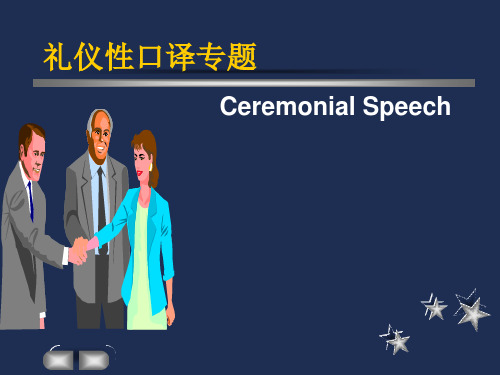
称呼
Ladies and gentlemen Your Excellency, My Chinese friends Honorable Mr. chair
May I propose a toast to the health of Your Excellency, to the health of all the Chinese friends, Cheers! 现在由我祝酒 为阁下的身体健康, 为所有中国朋友的身体健康, 为我们永久的友谊 干杯!
礼仪性口译专题
Ceremonial Speech
口译员由于其工作的特点,经常需要参加 各种外事活动,因此需要了解外事活动中基本 的行为规范,即礼仪性口译,也就是我们经常 所说的欢迎词,感谢词,祝酒词。 礼仪性口译翻译的原则:避免中式英语; 意合第一,夯实中英文基础,神合更佳。
Warm-up words
Thank you!
world-renowned 世界闻名 dynamism 充满活力 a special regard 特殊的敬意 memorable 值得回忆的 good faith 良好的诚意 strategic relationship 战略关系 flourishing 兴旺繁荣 mutual benefit 互惠互利
与“mutual ”搭配的词
mutual respect/benefit/understanding mutual trust/courtesy(礼尚往来) mutual complementarity(互补) mutual aid mutual promise mutual consent mutual affection etc.
表示感谢的常用形式
On behalf of… For myself and for our entire delegation, On behalf of all the members of my delegation and in my own name, For our Group and myself,
Lesson Six口译

尊敬的主席先生、女士们、先生们: 大家好!// 热烈欢迎大家在这春光明媚的日子里,来到我 们美丽的学校参加“中小企业创新发展国际论 坛。” 我谨代表此次论坛的主办方之一——本校的2万 名师生员工,向各位的到来表示最热烈的欢迎! 我相信此次大会的召开,一定会进一步推动我 校中小企业管理研究的开展,也会促进我校在 为中小企业服务方面更上一个新的台阶. 最后,在此预祝大会圆满成功!祝大家在会议 期间身体健康、心情愉快、工作顺利!
3. 大会所在地的许多教育界人士对本次会议的 召开给予了很大的帮助,对此我谨致以诚挚的 谢意,并祝愿本次会议圆满成功。 I wish to express our sincere thanks to the people of the local education community, whose generous help has made possible the successful commencement of this conference. And I wish this conference a complete success.
设宴为…洗尘/设宴款待… to hold/give/host a banquet in honor of… 以…的名义 in sb.’s name 热情洋溢的 gracious 圆满成功 complete success 尊敬的总统阁下 Respected Your Excellency Mr. President “海内存知己,天涯若比邻” Long distance separates no bosom friends.
1. It has been a great year, a year in which our joint venture had a remarkable sales growth. I hope we will be able to maintain this practical cooperative relationship and make the new year a more fruitful year. 2. Permit me, on behalf of the organizing committee, to extend a warm welcome to our guests of various circles, from home and abroad. 请允许我代表筹委会的全体人员,向海内外的 各界来宾表示热烈的欢迎!
礼仪致辞口译演讲稿范文

大家好!今天,我非常荣幸能够站在这里,担任本次活动的礼仪致辞口译。
首先,请允许我代表主办方,向各位远道而来的嘉宾表示最热烈的欢迎和最诚挚的感谢。
在座的各位,都是来自五湖四海的朋友,你们的光临使得这次活动更加圆满和成功。
在这里,我要特别感谢所有为本次活动的成功举办付出辛勤努力的同事们,是你们的努力和奉献,使得我们能够在这里欢聚一堂,共享这美好的时光。
首先,请允许我介绍一下本次活动的背景。
随着我国经济的快速发展和国际地位的不断提升,文化交流日益成为推动世界和平与发展的重要力量。
本次活动的主题是“友谊、合作、共赢”,旨在通过文化交流,增进各国人民之间的了解和友谊,促进世界和平与发展。
接下来,让我们共同回顾一下本次活动的精彩瞬间。
首先,我们有幸邀请到了来自世界各地的专家学者,他们为我们带来了关于文化交流的重要观点和独到见解。
他们的演讲不仅让我们开阔了视野,更让我们对文化交流的重要性有了更深刻的认识。
紧接着,我们举行了一系列丰富多彩的文化交流活动,包括文艺演出、书法绘画展览、传统手工艺展示等。
这些活动充分展示了我国悠久的历史文化和丰富的民族风情,同时也让各位嘉宾领略到了世界各国独特的文化魅力。
在此,我要特别感谢各位嘉宾对我们活动的关注和支持。
正是因为有了你们的积极参与,我们的活动才取得了如此丰硕的成果。
在此,我代表主办方,向各位嘉宾表示衷心的感谢!最后,我想借此机会,祝愿本次活动的成功举办,祝愿各位嘉宾在活动中收获满满,祝愿我们的友谊长存,祝愿世界和平与发展!谢谢大家!祝愿本次大会圆满成功!(以下为口译内容,供参考)Ladies and gentlemen, esteemed guests,It is my great honor to stand here today as the interpreter for the etiquette speech at this event. First and foremost, please allow me to extend the warmest welcome and sincerest gratitude to all of you who have traveled far to be here.Among us today are friends from all corners of the globe, and your presence has made this event even more perfect and successful. I would like to take this opportunity to express my heartfelt thanks to all thecolleagues who have worked tirelessly to make this event a reality. Itis your efforts and dedication that have brought us together to sharethis wonderful moment.Let us first take a brief look back at the highlights of this event. We are fortunate to have invited scholars and experts from around the world, who have shared with us their valuable insights and perspectives on cultural exchange. Their speeches have not only broadened our horizons but also deepened our understanding of the importance of cultural exchange.Following that, we have organized a series of colorful cultural exchange activities, including cultural performances, calligraphy and painting exhibitions, and traditional handicraft displays. These activities have fully showcased the long history and rich ethnic diversity of our country, while also allowing all of you to appreciate the unique charmof the cultures of other nations.In this regard, I would like to express my special gratitude to all of you for your attention and support to our event. It is because of your active participation that our event has achieved such fruitful results. On behalf of the organizers, I would like to extend my heartfelt thanks to all of you!Finally, I would like to take this opportunity to wish the successful outcome of this event, and I hope that all of you will have a rewarding experience here. I also wish for the enduring friendship among us andfor peace and development in the world.Thank you all! May this conference be a complete success!(Here follows the interpreted content for reference)。
礼仪性口译

礼仪性口译第一篇:礼仪性口译礼仪讲话的常见类型及其特点主要包括祝酒词、各种场合的开幕式(opening ceremony)和闭幕式(closing ceremony)祝词和答谢词, mostly including A: 称呼:即讲话的对象,如:Ladies and Gentlemen, Your honor Mr.Mayor, Respected Dr.smith, Your excellency President and Mrs.President(Bush)B.代表…向…表示感谢/祝贺等客套话,如:• On behalf of all the members of my delegation, I would like to take this opportunity to • • express our sincere thanks to our host for their gracious hospitality.C: 正文:既讲话的主要部分D: 结尾:在礼仪讲话的结尾部分,讲话人常常要再次向讲话的对象表示感谢。
如果是宴会祝酒辞,讲话人常常提议为…… 干杯。
C.表达感谢的词句 Gratitude I am full of gratitude to you for helping me with my English AppreciationThe audience showed their appreciation with loud cheers.He showed little appreciation of my advice I am very grateful to receive this award for “Best Actress”I can’t begin to tell you how much I appreciate this great honor(我说不出...,无法用语言来表达.)I also want to express my gratitude to all of my teachers over the years, but especially to my acting teacher.I want to express my appreciation to all of my friends for their support, especially to Martin Miller, for being there when I needed him.E句型• • • • • • I am very grateful…I want to thank …for…I want to express my gratitude to I want to express my appr eciation to… …means a great deal to me.Words can’texpress…F.练习• • • • 致开幕/闭幕/欢迎词: Deliver/make an opening/closing/welcome speech/address 陛下:YourHisHer Majesty 殿下:Highness/Excellency/Royal Highness • •• •• • • • • • • • •• •• •• • •• •请允许我借此机会,祝愿市长先生,祝愿出席今晚招待会的所有中国朋友,身体健康,万事如意。
英语口译课件_unit6礼仪性口译(2)

• 人员交往 people-to-people exchange
• 战略选择 strategic choice
• 高瞻远瞩 stand high and see far; take a broad and long-term view; show great foresight
第六单元 礼仪性口译(2)
Review
• 词汇翻译:• 远道而来 c Nhomakorabeame all the way from
• 尽情品尝 taste joyfully
• 美酒佳肴 delicious food and unique wine
• 无所拘束 in a more informal way
• 万事如意 all the best
• 良辰佳时 wonderful time
• 日新月异 ever-changing
• 宏观管理 macro-management
• 分工协作 collaboration and division
• 丰硕成果 abundant results
Preview
• 词汇翻译 (四字格短语)
• 广泛领域 in a wide range of areas
• 2. 日新月异的信息技术给我们带来了知识结构与内容的更新与革命, 而全球化的浪潮更是波及人类生活的每一个层面,改变着我们局限于 种族、地区与国家的传统的思维方式。
• The ever-changing IT brings us the renovation and revolution of knowledge structure and content. While the globalization tide further influences the every facet of human’s life and changes our traditional way of thinking constrained by ethnicity, region and country.
中级口译教程(word版)版第一部分
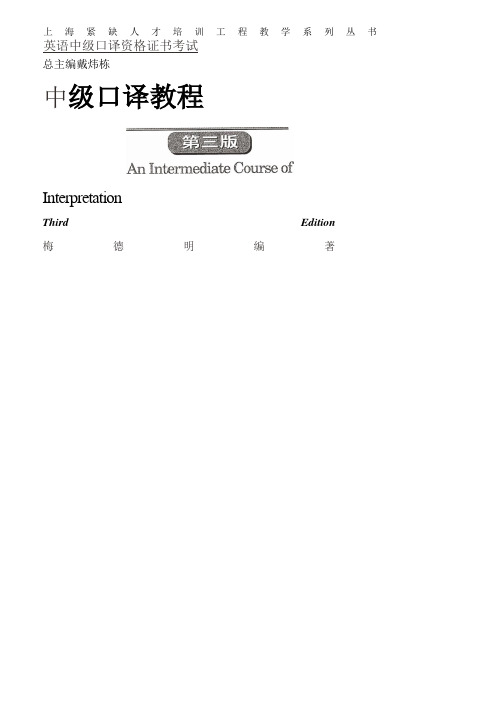
上海紧缺人才培训工程教学系列丛书英语中级口译资格证书考试总主编戴炜栋中级口译教程InterpretationThird Edition梅德明编著目录第一部分口译概论Part One An Overview of Interpretation一、口译历史The Development of Interpretation 2二、口译定义The Definition of Interpretation 5三、口译特点The Characteristics of Interpretation 7四、口译标准The Criteria of Interpretation 9五、口译过程The Process of Interpretation 11六、口译类型The Categorical Classification of Interpretation 15七、口译模式 A Tripartite Model of Interpretation 17八、译员素质Interpreter Qualification Requirements 19九、口译培训Interpreter Training 21十、口译研究Research in Interpretation and Interpreting 22第二部分培训教程Part Two A Training Course第一单元口译技巧_______________________________________ 30Unit One Introducing Skills in Interpreting1-1称谓口译 Interpreting Titles 301-2谚语口译 Interpreting Proverbs 331-3引语口译 Interpreting Quotations 371-4数字口译 Interpreting Numbers 401-5口译笔记 Note-Taking in Interpreting 46第二单元接待口译_______________________________________---------- —------------------------------------------------------- — ------------------------ 54Unit Two Interpreting for Reception Service2-1机场迎宾 Greetings at the Airport 542-2宾馆入住 Hotel Accommodation 562-3宴会招待 Banquet Service 582-4参观访问 Getting Around 61句子精练 Sentences in Focus 64参考译文 Reference Version 66第三单元会谈口译_________________________------------------------------------------------------------------- — ---------------------------'75Unit Three Interpreting Conversations3-1欢迎光临 Welcome 753-2投资意向 A Wish to Invest 773-3合资企业 Establishing a Joint Venture 803-4文化差异 Cultural Differences 83句子精练 Sentences in Focus 88参考译文 Reference Version 90第四单元访谈口译____________________________________Unit Four Interpreting Interviews 1004-1行在美国Travel in America 1004-2艾滋哀之The AIDS Epidemic 1044-3经营之道Business Management 1074-4音乐天才 A Gifted Musician 111句子精练 Sentences in Focus参考译文 Reference Version第五单元礼仪性口译(英译汉) 127Unit Five Interpreting Ceremonial SpeechesEnglish-Chinese Interpretation5 -1故地重游 Revisiting the Old Haunt 1275-2愉悦之旅 A Pleasant Trip 1295 -3共创未来 Our Future 1325-4新的长征 A New Long March 135句子精练 Sentences in Focus 139参考译文 Reference Version 142第六单元礼仪性口译(汉译英) 150Unit Six Interpreting Ceremonial Speeches Chinese-English Interpretation6- 1新春联欢 Celebrating the Spring Festival 1506-2圣诞晚会 At the Christmas Party 1516-3开幕祝词 An Opening Speech 1536-4展望未来 Looking Ahead 156句子精练 Sentences in Focus 159参考译文 Reference Version 161第七单元介绍性口译(英译汉)171Unit Seven Interpreting Informative Speeches English-Chinese Interpretation7-1绿色城市 A Green City 1717-2浪漫香槟 The Romantic Champagne 1747-3游客之居 A Place to Stay 1777-4教堂之游 A Tour around the Cathedral 179句子精练 Sentences in Focus 182参考译文 Reference Version 185第八单元介绍性口译(汉译英) ___________ 192Unit Eight Interpreting Informative Speeches Chinese-English Interpretation8 -1丝绸之路 The Silk Road 1928-2传统节日 Traditional Holidays 1948-3教育之本 The Purpose of Education ‘1978-4出版王者 The Super-Publisher 200句子精练 Sentences in Focus 203参考译文 Reference Version 205第九单元说服性口译(英译汉) __________________ 218Unit Nine Interpreting Persuasive SpeechesEnglish-Chinese Interpretation9-1强市之路 The Road to a Prosperous City 2189-2广而误之 The Effects of Misleading Advertising 2249-3大学精神 The University Spirit 2279-4继往开来 The New Beginning of an Old Story 231句子精练 Sentences in Focus 235参考译文 Reference Version 238第十单元说服性口译(汉译英) ____________________ 247Unit T en Interpreting Persuasive SpeechesChinese-English Interpretation10 -1 第二文化 Acquiring a Sepond Culture 247 10-2 环境保护 Environmental Protection 249 10-3 迎接挑战 Meeting the Challenge 252 10-4 习武健身 Practising Martial Art for Your Health 256句子精练 Sentences in Focus 259参考译文 Reference Version 261第十一单元学术性口译(英译汉)275Unit Eleven Interpreting Academic SpeechesEnglish-Chinese Interpretation11-1 语言系统 The Linguistic System 275 11-2 人机之争 Two Kinds of Brain . 277 11 - 3 生物革命 The Biological Revolution 280 11-4 股票市场 The Stock Market 285句子精练 Sentences in Focus '' 288参考译文 Reference Version 291第十二单元学术性口译(汉译英) 299_Unit Twelve Interpreting Academic SpeechesChinese-English Interpretation12-1 语用能力 Communicative Competence 299 12-2 文化冲突〇n Cultural Clashes 301 12-3 书法艺术 The Art of Calligraphy 303 12-4 社区服务 Community Service 305句子精练 Sentences in Focus 308参考译文 Reference Version 310第十三单元商务性口译(英译汉)Unit Thirteen Interpreting Business Speeches321English-Chinese Interpretation13-1企业文化 Entrepreneurial Culture 321 13-2认识债券 Getting to Know Bonds 325 13-3硅谷之贵 The Unique Silicon Valley 329 13-4专利法规〇n Patent Laws 333句子精练 Sentences in Focus 336参考译文 Reference Version 338第十四单元商务性口译(汉译英)_________________ 347 Unit Fourteen Interpreting Business SpeechesChinese-English Interpretation14-1双边经贸 Bilateral Economy and Trade 34714-2亚洲合作 Asian Cooperation 35014-3夕卜资企业 Foreign-Capital Enterprises 35214-4经济关系 Economic Links 354句子精练 Sentences in Focus 358参考译文 Reference Version 360第十五单元科普性口译(英译汉) 373Unit Fifteen Interpreting Popular Science Speeches English-Chinese Interpretation15-1睡眠与梦 Sleep and Dream 37315-2音响今昔 The Sound Reproduction Industry 37515-3遗传信息 Genetic Information 37815-4左脑之优 Left Hemispheric Dominance 380句子精练 Sentences in Focus 384参考译文 Reference Version第十六单元科普性口译(汉译英) __________________ ____Unit Sixteen Interpreting Popular Science SpeechesChinese-English Interpretation16-1汉语概要 The ABC of Chinese 39416-2进化本质 The Nature of Biological Evolution 39616-3蚊虫之祸 The Power of the Petty Mosquito 39916-4用筷技艺 The Magic Chopsticks 401句子精练 Sentences in Focus 404参考译文 Reference Version 406第三部分口译测试I Part Three Interpretation Test in Brief口译测试概要与实践________________________________Interpretation T est : Essentials and Practice英语中级口译考试的要求、形式及题型Intermediate Interpretation T est::Requirement, Structure and Form 420英语中级口译模拟测试Model T ests for Intermediate Interpretation T est 423英语中级口译模拟测试参考答案Reference Version for Intermediate Model T ests 458后记一.口译历史The Development of Interpretation一种语言文字所表达的意义经由另一种语言文字转达出来叫做翻译。
【最新文档】礼仪英语常用口译-范文模板 (27页)
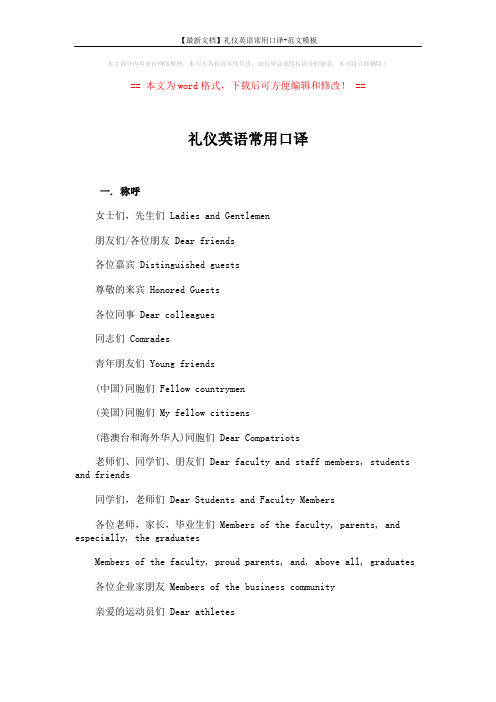
本文部分内容来自网络整理,本司不为其真实性负责,如有异议或侵权请及时联系,本司将立即删除!== 本文为word格式,下载后可方便编辑和修改! ==礼仪英语常用口译一. 称呼女士们,先生们 Ladies and Gentlemen朋友们/各位朋友 Dear friends各位嘉宾 Distinguished guests尊敬的来宾 Honored Guests各位同事 Dear colleagues同志们 Comrades青年朋友们 Young friends(中国)同胞们 Fellow countrymen(美国)同胞们 My fellow citizens(港澳台和海外华人)同胞们 Dear Compatriots老师们、同学们、朋友们 Dear faculty and staff members, students and friends同学们,老师们 Dear Students and Faculty Members各位老师,家长,毕业生们 Members of the faculty, parents, and especially, the graduatesMembers of the faculty, proud parents, and, above all, graduates各位企业家朋友 Members of the business community亲爱的运动员们 Dear athletes尊敬的各位国家元首、政府首脑和王室代表Distinguished Heads of State and Government and Representatives of Royal Families尊敬的各位使节、代表和夫人Your Excellencies Diplomatic Envoys, Representatives of International Organizations and Your Spouses各位使节及使团同事 Excellencies and Colleagues of the Diplomatic Corps各位团长 Heads of Delegations各位议员朋友 My Lords and MPs中央政府驻港机构各位领导 Heads of local offices of the Central Government尊敬的胡领导人主席和夫人Your Excellency President Hu Jintao and Madame Liu Yongqing尊敬的布什总统和夫人 Mr. President and Mrs. Bush尊敬的罗格主席和夫人 Respected IOC President Rogge and Mrs Rogge尊敬的克雷文主席和夫人 Respected President Philip Craven and Mrs Craven尊敬的各位国际奥委会委员 Distinguished Members of the International Olympic Committee主席先生/总统先生 Mr. President总理先生 Mr. Premier / Prime Minister总统女士 Madame President尊敬的阿罗约总统阁下 Your Excellency President Gloria Macapagal Arroyo国王和王后陛下 Your Majesties各位殿下 Your Royal Highnesses尊敬的桑德罗·邦迪部长 Respected Minister Sen. Sandro Bondi尊敬的戴秉国国务委员 Your Excellency State Councilor Dai Bingguo尊敬的李省长 Honorable Governor Li尊敬的杨市长 Honorable Mayor Yang团中央第一书记陆昊先生 First Secretary Mr. Lu Hao高教授及夫人 Professor and Mrs Kao尊敬的内格罗蓬特常务副国务卿 Honorable Deputy Secretary of State John Negroponte尊敬的亨特勋爵 Lord Hunt尊敬的白乐威爵士 Sir David Brewer尊敬的阿姆鲁·穆萨秘书长 Your Excellency Secretary General Amr Moussa(香港)政务司司长 The Honourable Chief Secretary for Administration尊敬的(国家林业局保护司)贾建生副司长 Deputy Director General Jia Jiansheng尊敬的刘立军处长 Division Director Liu Lijun尊敬的耶鲁大学校长理查德·莱文先生 Dear Mr. Richard Levin, President of Yale University,尊敬的(剑桥大学)理查德校长 Vice Chancellor Alison Richard二. 高兴出席活动1. 自我介绍大家好!我是白小琳,美国驻武汉总领事,也是今天晚上美国国庆招待会的主持人。
- 1、下载文档前请自行甄别文档内容的完整性,平台不提供额外的编辑、内容补充、找答案等附加服务。
- 2、"仅部分预览"的文档,不可在线预览部分如存在完整性等问题,可反馈申请退款(可完整预览的文档不适用该条件!)。
- 3、如文档侵犯您的权益,请联系客服反馈,我们会尽快为您处理(人工客服工作时间:9:00-18:30)。
释义派口译理论指导下的口译程序: 理解
1. 2. 3.
脱离语言外壳
表达
语言含义同语言外知识结合产生意义 伴随意义产生脱离语言外壳 使用恰当形式自由表达这一意义
例句: Today, China’s economy crackles with the dynamics of changes. 今天,中国经济有了剧烈的动态变化。(语言翻译) 今天,中国经济突飞猛进,日新月异。(意义翻译) In Bangladesh, about 70% of the people die without seeing a doctor. 70%的人没有来得及看医生就死了。 (语言翻译) 70%的人去世前没条件看病。 (意义翻译) 要想正确理解意义,必须启动语言外知识。
释义派口译理论指导下的口译程序 理解 脱离语言外壳 表达
翻译的忠实性体现在:忠实于讲话人,忠实于译入语,忠实于听众。 理解后的表达不仅要通畅,而且要做到言语得当,恰如其分、准确清 晰。 推荐书目: 《口译技巧——思维科学与口译推理教学法》 刘和平 著 《口译理论与教学》 刘和平 著 《口译训练指南》 塞莱斯科维奇 勒代雷 著 闫素伟 邵炜 译
Four-character Chinese phrases are highly succinct and they entail the abundant sense of emotional, thinking, comparative, etc. So it is hard to interpret them word to word between Chinese and English. The very common way adopted is to interpret the senses. 明月当空: moon-lit ( sense: the moon is lit in the sky) 尽兴尽致:sense:enjoy every minute of … 良辰佳时:sense: wonderful time 万事如意: 10,000 actually is a unreliable figure, it means all. sense: I wish you all the best. May all our wishes be fulfilled. May all our wishes come true. May everything go well with you.
释意学派
概括说来, 概括说来,释意理论不是把翻译看作一个从源语言到 目标语言的单向解码过程, 目标语言的单向解码过程,而是将其视为一个理解思想与重 新表达思想的动态过程。 新表达思想的动态过程。
Focus
1. Stereotyped expressions interpreting. 2. Interpreting Chinese phrases of four-character. 3. Brief introduction to Interpreting School. 4. Problems students meet with expressing in target languages.
Interpreting Ceremonial Speeches
Chinese-English Interpretation
Teaching contents
A. 6-1 新春联欢 Celebrating the Spring Festival Vocabulary work & Text for Interpretation B. 6-2 圣诞晚会 At the Christmas Party Vocabulary work & Text for Interpretation C. 6-3 开幕祝词 An Opening Speech Vocabulary work & Text for Interpretation D. 6-4 展望未来 Looking Ahead Vocabulary work & Text for Interpretation
Answers:
1. What are the characteristics of the ceremonial speeches?
The speaker likes to speak in the ceremony occasions by a very polite and gentle way. There are always some stereotyped expressions in the speech, especially in the beginning part and the ending part. eg.
释意学派
20世纪60年代末产生于法国的一个探讨口译与非文学文本笔译原理与 教学的学派。 代表人物:塞莱丝柯维奇/勒代雷 该派认为翻译即释意;是译者通过语言符号和自己的认知补充对原文 意思所作的一种解释;译者应追求的不是语言单位的对等,而是原文 意思或效果的等值:该派理论直接来源于口译实践,其观点对于翻译 研究有着独特的启示。
Answers
3. What’s the difference of Chinese language and English language in structure? Chinese Language focuses on: Sense Sentences Invisible sense English language focuses on: Structure SVO; SOV; VSO, VOS, OVS, OSV Visible structure
汉语中“四字格”短语如何翻译? 汉语中“四字格”短语如何翻译? 明月当空 全体同仁 远道而来 美酒佳肴 才华横溢 无所拘束 辉煌业绩 万事如意 良辰佳时 尽兴尽致
Question: How to interpret Chinese phrases with four characters? 汉语中“四字格”短语如何翻译? 汉语中“四字格”短语如何翻译?
句子翻译练习
中华民族的祖先曾追求国这样一种境界: 为天地立心,为生民立命, 为往圣继绝学,为万事开太平。 Chinese forefathers formulated their goals as follows: To ordain conscience for Heaven and Earth, To secure life and fortune for the people, To continue lost teachings for past sages, To establish peace for all the future generations.
Listen to the recordings Questions:
1. What are the characteristics of the ceremonial speeches? 2. How to interpret Chinese phrases of four-character? 3. What’s the difference of Chinese language and English language in structure?
释意学派
释义派理论对于翻译过程的研究: 释义派理论对于翻译过程的研究 1. “话语阐释”(interpretation or exegesis of discourse) 2. “脱离语言外壳 ( déverbalisation /de-verbalization) 脱离语言外壳 ) 3. 原语信息内容的重组(reformulation) 释义派口译理论指导下的口译程序: 理解 脱离语言外壳 表达
句子翻译练习
1. 中华民族尽管灾难深重,饱受凌辱,但是始终自强不息。 Despite compounded disasters and humiliation, the Chinese nation never gave up and managed to emerge from each setback stronger than before. 2. 封建王朝的愚昧和腐败及闭关锁国,导致社会停滞,国力衰竭, 列强频频入侵。 The ignorance, corruption and self-imposed seclusion of the feudal dynasties led China to prolonged social stagnation, declining national strength and repeated invasions by the foreign powers. 3.当然中国政府和人民有足够的信心,励精图治,艰苦奋斗,派出万 难,实现我们的雄心壮志。 Of course, the Chinese government and people are confident enough to overcome all difficulties and achieve our ambitious goals through our vigorous efforts.
Eg. “有朋自远方来,不亦乐乎” Sense: 有来自远方的朋友是多么高兴啊! It is such delightful to have friends coming from afar!
汉英语言的特点: 汉英语言的特点:
汉英两种语言,汉语重“意和”,英语重“形和”。 汉语在结构上无焦点,各分句以意相连,各语法成分隐含在词语铺排 的线形流程中。 英语句型呈空间立体布局。其句式以SV为主干构成全局中心,动 词变化涵盖了大部分结构信息。 汉译英的过程,就是一个化整为零的过程,即将汉语“隐性”的语义 关 系化为英语“显形”的外形结构。在此过程中,我们需要精确透彻地 分 析原文逻辑关系,找准语义中心;并把SV主干定在原文语义中心上; 然后将原汉语次要部分割分句按英语的各种语法手段分别有机地挂连 在SV主干上,完成全句的空间搭架。
